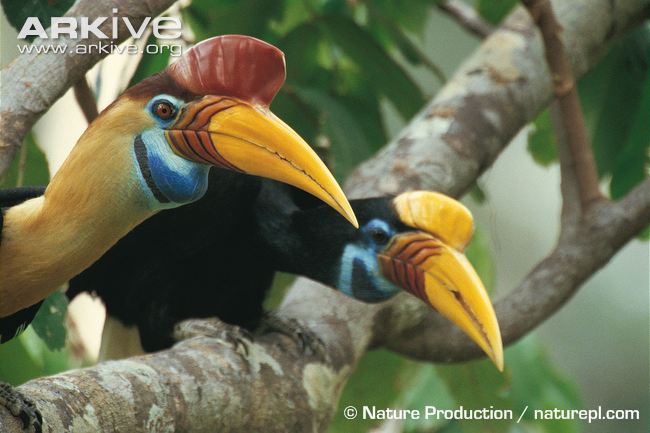| Citation |
|
Description |
Geographic Range [top]
Range Description: This species is endemic to Sulawesi and offshore islands of Lembeh, Togian Islands, Muna and Butung, Indonesia. It is described as common in at least parts of its range (del Hoyo et al. 2001). However, a recent analysis has suggested that this species may be declining at a rate approaching 40% over three generations based on recent and ongoing rates of habitat loss on Sulawesi (D. Holmes in litt. 1999, Kinnaird and OBrien 2007).
Countries occurrence:
Native:
Indonesia
Additional data:
? Continuing decline in area of occupancy (AOO): Unknown
? Extreme fluctuations in area of occupancy (AOO): No ? Estimated extent of occurrence (EOO) - km2: 432000
? Continuing decline in extent of occurrence (EOO): Unknown ? Extreme fluctuations in extent of occurrence (EOO): No
? Continuing decline in number of locations: Unknown
? Extreme fluctuations in the number of locations: No
? Upper elevation limit (metres): 1800
Range Map: Click here to open the map viewer and explore range.
Population [top]
Population: The global population size has not been quantified, but the species is reported to be locally very common (del Hoyo et al. 2001, Kinnarid and OBrien 2007).
Trend Justification: The population is suspected to be declining rapidly owing to ongoing habitat destruction (16.9% forest loss per ten years during 1985-1997; 36.1% loss per ten years during 1997-2001 on Sulawesi [based on D. Holmes in litt. 1999 and Kinnaird and O’Brien 2007]) and hunting for food, gold mining and fires (del Hoyo et al. 2001).
Current Population Trend: Decreasing
Additional data:
? Number of mature individuals: Unknown ? Continuing decline of mature individuals: Yes
? Extreme fluctuations: No ? Population severely fragmented: No
? Continuing decline in subpopulations: Unknown
? Extreme fluctuations in subpopulations: No ? All individuals in one subpopulation: No
Habitat and Ecology [top]
Habitat and Ecology: The species inhabits evergreen forest up to 1,800 m asl, especially in lowalnds below 1,100 m asl, where it extends into patches of secondary forest, woodland and plantations to forage. Feeds mainly on fruit, but also on animals, including insects, bird eggs and nestlings. It forages mainly in the canopy, even plucking off fruits in flight. Also digs in soft wood. Chases off other birds and primates at feeding sites. In Gorontalo, Sulawesi, the species has been observed foraging in primary and abandoned selectively logged forest, including those in fairly close proximity to human settlements (D. Mulyawati in litt. 2010). It requires large trees for breeding, nesting in natural holes 13-53 m up in tall forests trees (Kinnaird and OBrien 1999, del Hoyo et al. 2001, F. Lambert in litt. 2011).
Systems: Terrestrial
Continuing decline in area, extent and/or quality of habitat: Yes
Generation Length (years): 19
Movement patterns: Not a Migrant
Threats [top]
Major Threat(s): The species is threatened with habitat destruction, with forest on Sulawesi being lost at a rate of 16.9% per ten years during 1985-1997; and 36.1% per ten years during 1997-2001 (based on D. Holmes in litt. 1999 and Kinnaird and O’Brien 2007). The speciess specialised breeding requirements (including dependence on large trees) makes them particularly vulnerable to forest loss and degradation (e.g. Winarni and Jones 2012). Hunting is a serious threat, as well as gold mining and fires (following exceptional fires in 1997, fieldwork showed a significant drop in breeding success and population recruitment in subsequent years) (del Hoyo et al. 2001)
Conservation Actions [top]
Conservation Actions: Conservation measures underway
None is known
Conservation measures proposed
Conduct further surveys to clarify its current distribution and status. Monitor trends in the population. Protect remaining extensive tracts of forest, extend existing protected areas where appropriate, and strictly control hunting in protected areas. Lobby for improved logging practices that leave patches of old growth or large trees. Design and implement hornbill conservation programmes aimed at reducing hunting levels.
Amended [top]
Amended reason: Edited Population Justification, Threats, Habitats and Ecology and Conservation Actions Information text, with a consequent change to Actions Needed. Added a common name, references, a Contributor and a Facilitator/Compiler.
Citation: BirdLife International. 2017. Rhyticeros cassidix (amended version of 2016 assessment). The IUCN Red List of Threatened Species 2017: e.T22682525A117182222. http://dx.doi.org/10.2305/IUCN.UK.2017-3.RLTS.T22682525A117182222.en. Downloaded on 07 September 2018.
Disclaimer: To make use of this information, please check the .
Feedback: If you see any errors or have any questions or suggestions on what is shown on this page, please provide us with feedback so that we can correct or extend the information provided
|

